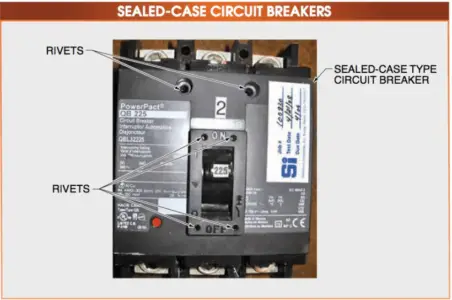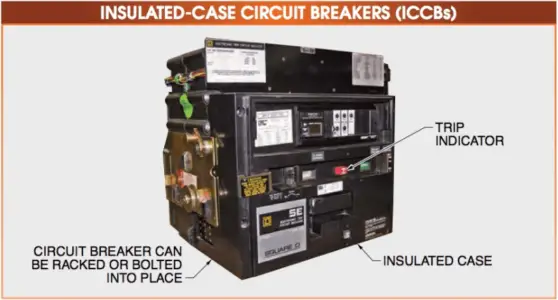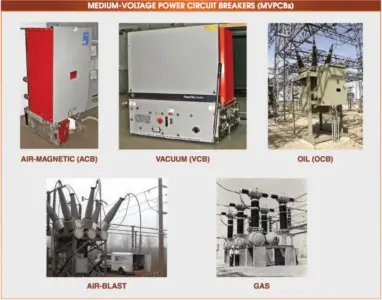Learn about Low-Voltage and Medium-Voltage circuit breaker types and their uses/applications.
Low-voltage circuit breakers are typically used in applications such as lighting circuits, motor control centers, feeder circuits, and any application in which electrical power needs to be turned on and off and overcurrent protection is required.
Medium-voltage circuit breakers are used in many of the same types of applications as low-voltage circuit breakers but rely on protective relays rather than built-in OCPDs to provide a trip signal.
Low-Voltage Circuit Breaker Types
There are many methods of identifying circuit breakers. Low-voltage circuit breakers are typically classified by their configuration. Types of low-voltage circuit breakers include molded-case circuit breakers, insulated-case circuit breakers, and low-voltage power circuit breakers.
Common voltage levels for low-voltage circuit breakers include 120/208 V and 277/480 V, and the voltage can range up to 635 V.
Molded-Case Circuit Breakers (MCCB)
With molded-case circuit breakers (MCCBs), the case supports the components and is also part of the insulating structure. MCCBs typically have thermal-magnetic OCPDs built into their cases.
According to IEEE standard C37.100, “A molded case circuit breaker is one that is assembled as an integral unit in a supporting and enclosing housing of insulating material.”
The most common types of MCCBs include sealed-case, interchangeable trip, and molded-case switch circuit breakers. A sealed-case circuit breaker is a type of MCCB that cannot be opened for maintenance or renewal because its UL listing will be nullified. MCCBs that have tar over the case screws, riveted covers, or paper seals either on the joint between the two case sections or over the case screws are considered sealed- case MCCBs. See Figure 1.

Figure 1. Sealed-Case Circuit Breaker Labeled Diagram
With interchangeable trip circuit breakers, the overcurrent unit can be changed as needed. The OCPD rating cannot exceed 80% of the circuit breaker frame rating. Changes to the continuous current rating of electronic interchangeable trip units are made by changing the rating plug. If the interchangeable trip unit is electromechanical, the entire trip unit has to be changed. Molded-case switches are externally identical to thermal-magnetic MCCBs but do not have built-in OCPDs. The only current rating is the frame rating. They are often used with motor control centers in which protection is provided by some other device.
Insulated-Case Circuit Breakers (ICCB)
Insulated-case circuit breakers (ICCBs) are similar in appearance to MCCBs but have higher short-circuit current ratings and usually have electronic OCPDs rather than thermal-magnetic trip units.
ICCBs can have a bolt-in or draw-out design and are often used in place of low-voltage power circuit breakers. ICCBs typically offer high short-circuit current ratings, have electronic OCPDs and cost less than low-voltage power circuit breakers of comparable ratings. See Figure 2.

Figure 2.Insulated-Case Circuit Breaker Labeled Diagram
Low-Voltage Power Circuit Breakers
Low-voltage power circuit breakers (LVPCBs) are defined by IEEE C37.100 as “for use on circuits rated 1000 volts AC and below, or 3000 volts DC and below, but not including molded-case circuit breakers.”
An LVPCB is also referred to as an air-frame breaker because the frame of the circuit breaker is only used to support the components and is not part of the insulation system. See Figure 3.

Figure 3. Low-Voltage Power Circuit Breaker Labeled Diagram
Medium-Voltage Power Circuit Breaker Types
A medium-voltage power circuit breaker (MVPCB) is a circuit breaker that operates with voltages ranging from 2300 V to 69,000 V.
The most common method of classifying these circuit breakers is by using their arc-quenching medium. MVPCBs are classified as air-magnetic, vacuum, oil, air-blast, and gas circuit breakers. See Figure 4.
Note: Most metal-clad circuit breakers, which are a type of medium-voltage circuit breaker, operate at 4160 V and 13,200 V/13,800 V, although vacuum circuit breakers can have voltage ratings up to 38,000 V.

Figure 4. Medium-Voltage Power Circuit Breaker Labeled Diagram
Air-Magnetic Circuit Breakers (ACB)
Air-magnetic circuit breakers (ACBs) are the most common type of MVPCB. With ACBs, arc interruption takes place in the air and is usually assisted by arc chutes, blowout coils, and puffer tubes. The practical limit for ACBs using arc chutes (metal-clad switchgear) is about 15 kV. Due to complex designs, maintenance requirements, and size installed ACBs are being replaced by vacuum circuit breakers.
Vacuum Circuit Breakers (VCB)
Vacuum breakers (VCBs) are used to replace air- magnetic breakers, mostly because they are smaller, lighter, and require a lot less maintenance. VCBs use self-contained bottles with an internal vacuum to interrupt arcing. Since the vacuum in the bottles is not a perfect vacuum, a small amount of arcing occurs. The vacuum vaporizes a small amount of contact material, but most of the vaporized metal reforms onto the contacts. The practical limit for single-bottle vacuum circuit breaker technology is 15 kV, but by installing two bottles in series, voltages up to 38 kV can be interrupted.
Oil Circuit Breakers (OCB)
Oil circuit breakers (OCBs) use mineral oil in large tanks to interrupt arcs. Arc interrupters force the oil through the arcs. At high voltages (230 kV), oil blast interrupters force oil through the arcs by using internal pumps and pistons. However, OCBs are not efficient at these voltages because the quantity of oil needed increases tremendously as the voltage rating increases. As with ACBs, OCBs are being phased out of service in favor of more efficient types of circuit breakers.
Air-Blast Circuit Breakers
Air-blast circuit breakers are one of the earliest types of circuit breakers used with 345 kV and 550 kV systems. With air-blast circuit breakers, dry, high-pressure air (about 240 psi) is forced across the arc when the contacts open. The high-pressure air extinguishes the arc. Moisture is always an issue with this type of circuit breaker, even more than with OCBs or gas circuit breakers. Leaks associated with the use of high-pressure air systems are also problematic. These types of circuit breakers have mostly been phased out by the utilities that used them.
Gas Circuit Breakers
Gas circuit breakers, which use sulfur hexafluoride (SF6) gas, are rapidly replacing oil and air-blast circuit breakers. SF6 is a high- density gas that has high dielectric strength. Gas circuit breakers use SF6 gas to interrupt arcs. The dielectric strength of the gas increases as pressure increases and the gas is used in circuit breakers from 15 kV to 765 kV.